The current energy creation plants
VerifiedAdded on 2022/09/08
|9
|2308
|27
AI Summary
Contribute Materials
Your contribution can guide someone’s learning journey. Share your
documents today.
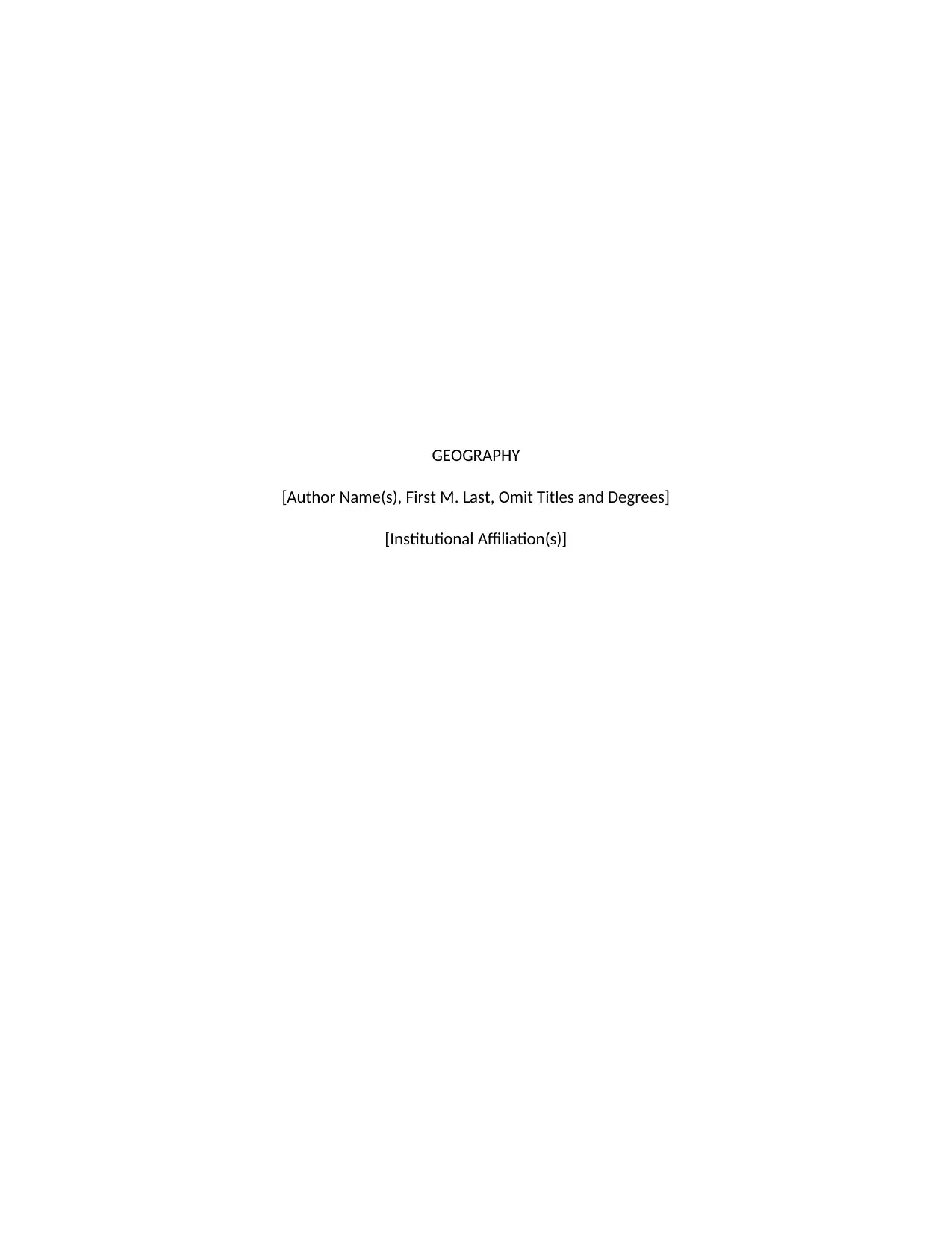
GEOGRAPHY
[Author Name(s), First M. Last, Omit Titles and Degrees]
[Institutional Affiliation(s)]
[Author Name(s), First M. Last, Omit Titles and Degrees]
[Institutional Affiliation(s)]
Secure Best Marks with AI Grader
Need help grading? Try our AI Grader for instant feedback on your assignments.
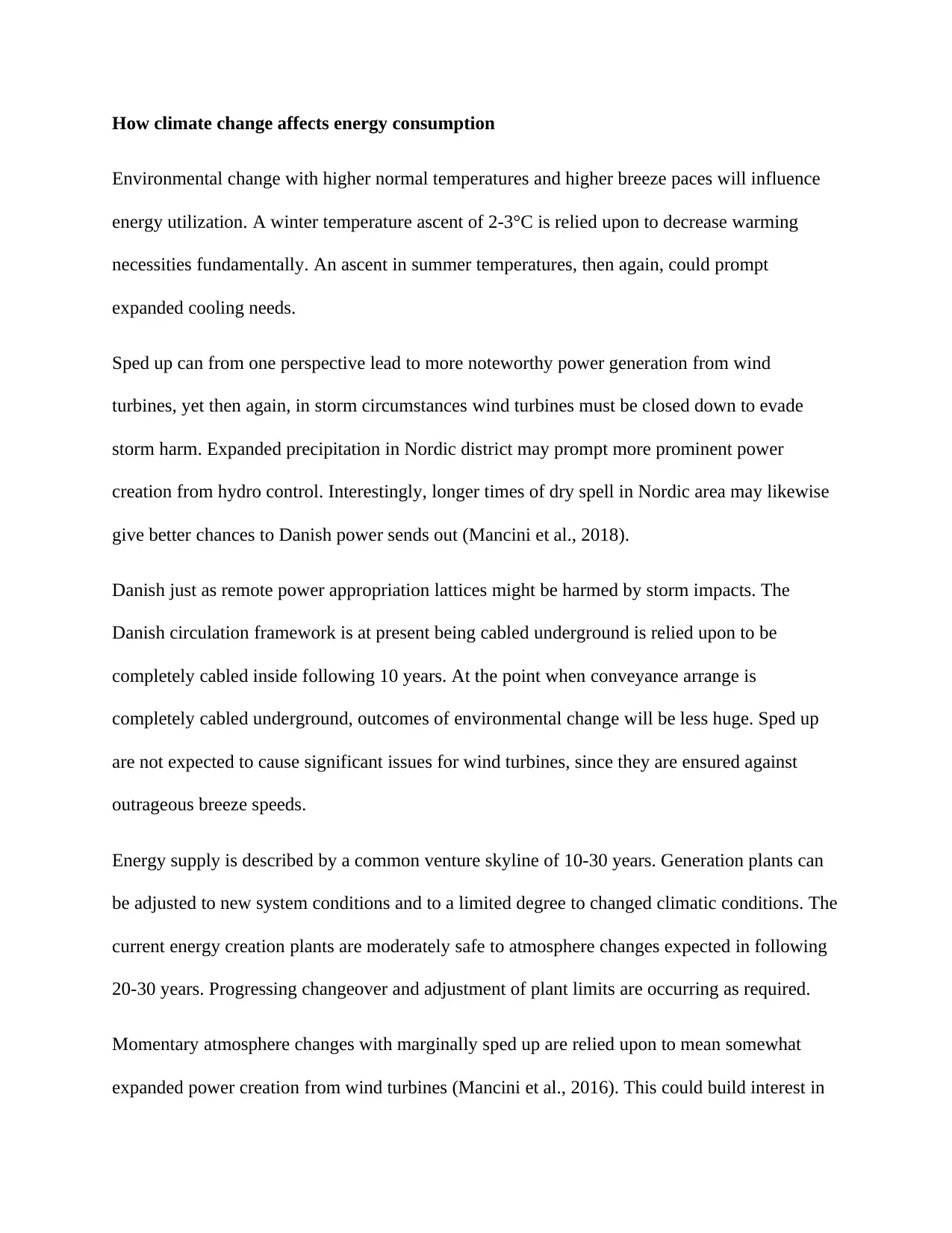
How climate change affects energy consumption
Environmental change with higher normal temperatures and higher breeze paces will influence
energy utilization. A winter temperature ascent of 2-3°C is relied upon to decrease warming
necessities fundamentally. An ascent in summer temperatures, then again, could prompt
expanded cooling needs.
Sped up can from one perspective lead to more noteworthy power generation from wind
turbines, yet then again, in storm circumstances wind turbines must be closed down to evade
storm harm. Expanded precipitation in Nordic district may prompt more prominent power
creation from hydro control. Interestingly, longer times of dry spell in Nordic area may likewise
give better chances to Danish power sends out (Mancini et al., 2018).
Danish just as remote power appropriation lattices might be harmed by storm impacts. The
Danish circulation framework is at present being cabled underground is relied upon to be
completely cabled inside following 10 years. At the point when conveyance arrange is
completely cabled underground, outcomes of environmental change will be less huge. Sped up
are not expected to cause significant issues for wind turbines, since they are ensured against
outrageous breeze speeds.
Energy supply is described by a common venture skyline of 10-30 years. Generation plants can
be adjusted to new system conditions and to a limited degree to changed climatic conditions. The
current energy creation plants are moderately safe to atmosphere changes expected in following
20-30 years. Progressing changeover and adjustment of plant limits are occurring as required.
Momentary atmosphere changes with marginally sped up are relied upon to mean somewhat
expanded power creation from wind turbines (Mancini et al., 2016). This could build interest in
Environmental change with higher normal temperatures and higher breeze paces will influence
energy utilization. A winter temperature ascent of 2-3°C is relied upon to decrease warming
necessities fundamentally. An ascent in summer temperatures, then again, could prompt
expanded cooling needs.
Sped up can from one perspective lead to more noteworthy power generation from wind
turbines, yet then again, in storm circumstances wind turbines must be closed down to evade
storm harm. Expanded precipitation in Nordic district may prompt more prominent power
creation from hydro control. Interestingly, longer times of dry spell in Nordic area may likewise
give better chances to Danish power sends out (Mancini et al., 2018).
Danish just as remote power appropriation lattices might be harmed by storm impacts. The
Danish circulation framework is at present being cabled underground is relied upon to be
completely cabled inside following 10 years. At the point when conveyance arrange is
completely cabled underground, outcomes of environmental change will be less huge. Sped up
are not expected to cause significant issues for wind turbines, since they are ensured against
outrageous breeze speeds.
Energy supply is described by a common venture skyline of 10-30 years. Generation plants can
be adjusted to new system conditions and to a limited degree to changed climatic conditions. The
current energy creation plants are moderately safe to atmosphere changes expected in following
20-30 years. Progressing changeover and adjustment of plant limits are occurring as required.
Momentary atmosphere changes with marginally sped up are relied upon to mean somewhat
expanded power creation from wind turbines (Mancini et al., 2016). This could build interest in
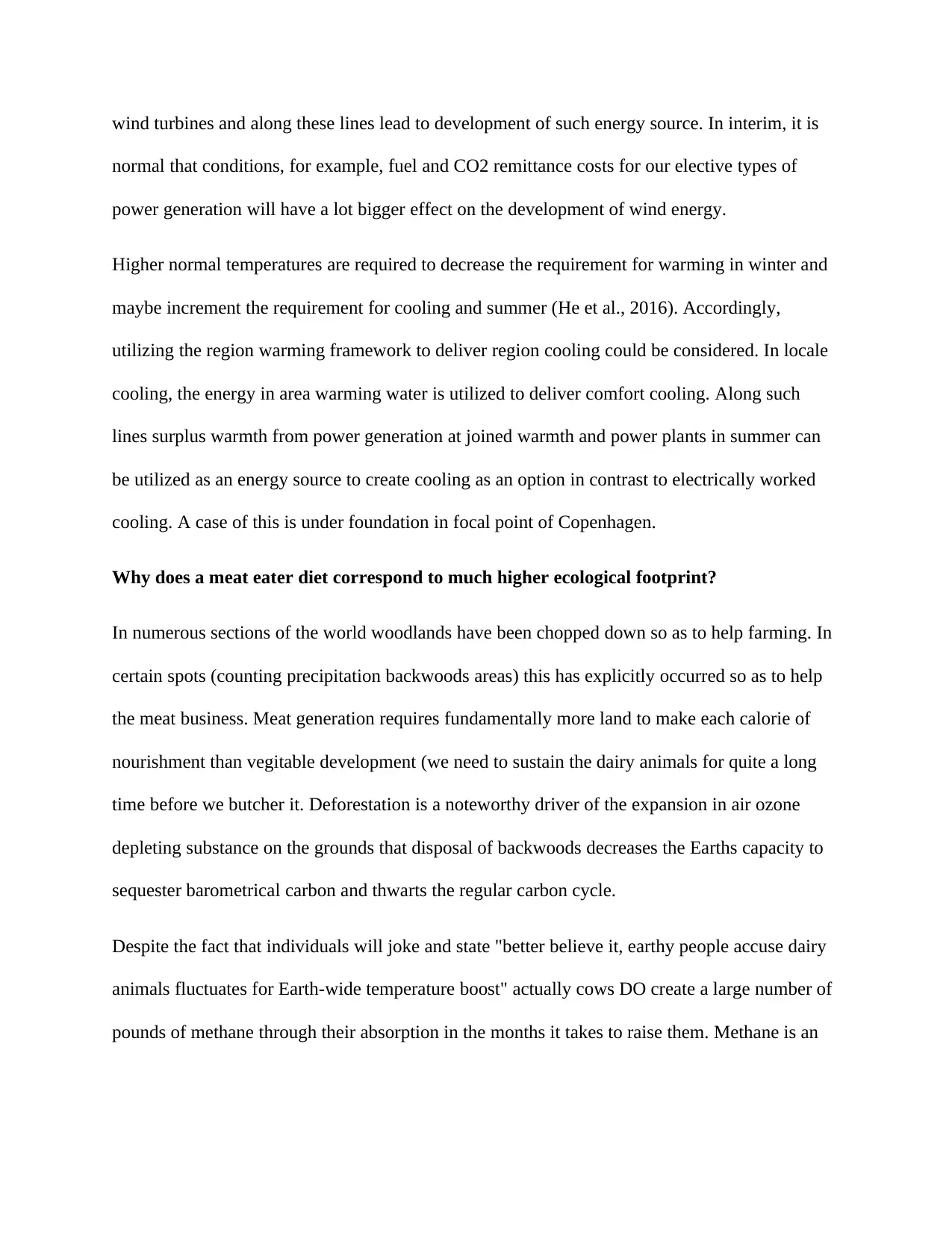
wind turbines and along these lines lead to development of such energy source. In interim, it is
normal that conditions, for example, fuel and CO2 remittance costs for our elective types of
power generation will have a lot bigger effect on the development of wind energy.
Higher normal temperatures are required to decrease the requirement for warming in winter and
maybe increment the requirement for cooling and summer (He et al., 2016). Accordingly,
utilizing the region warming framework to deliver region cooling could be considered. In locale
cooling, the energy in area warming water is utilized to deliver comfort cooling. Along such
lines surplus warmth from power generation at joined warmth and power plants in summer can
be utilized as an energy source to create cooling as an option in contrast to electrically worked
cooling. A case of this is under foundation in focal point of Copenhagen.
Why does a meat eater diet correspond to much higher ecological footprint?
In numerous sections of the world woodlands have been chopped down so as to help farming. In
certain spots (counting precipitation backwoods areas) this has explicitly occurred so as to help
the meat business. Meat generation requires fundamentally more land to make each calorie of
nourishment than vegitable development (we need to sustain the dairy animals for quite a long
time before we butcher it. Deforestation is a noteworthy driver of the expansion in air ozone
depleting substance on the grounds that disposal of backwoods decreases the Earths capacity to
sequester barometrical carbon and thwarts the regular carbon cycle.
Despite the fact that individuals will joke and state "better believe it, earthy people accuse dairy
animals fluctuates for Earth-wide temperature boost" actually cows DO create a large number of
pounds of methane through their absorption in the months it takes to raise them. Methane is an
normal that conditions, for example, fuel and CO2 remittance costs for our elective types of
power generation will have a lot bigger effect on the development of wind energy.
Higher normal temperatures are required to decrease the requirement for warming in winter and
maybe increment the requirement for cooling and summer (He et al., 2016). Accordingly,
utilizing the region warming framework to deliver region cooling could be considered. In locale
cooling, the energy in area warming water is utilized to deliver comfort cooling. Along such
lines surplus warmth from power generation at joined warmth and power plants in summer can
be utilized as an energy source to create cooling as an option in contrast to electrically worked
cooling. A case of this is under foundation in focal point of Copenhagen.
Why does a meat eater diet correspond to much higher ecological footprint?
In numerous sections of the world woodlands have been chopped down so as to help farming. In
certain spots (counting precipitation backwoods areas) this has explicitly occurred so as to help
the meat business. Meat generation requires fundamentally more land to make each calorie of
nourishment than vegitable development (we need to sustain the dairy animals for quite a long
time before we butcher it. Deforestation is a noteworthy driver of the expansion in air ozone
depleting substance on the grounds that disposal of backwoods decreases the Earths capacity to
sequester barometrical carbon and thwarts the regular carbon cycle.
Despite the fact that individuals will joke and state "better believe it, earthy people accuse dairy
animals fluctuates for Earth-wide temperature boost" actually cows DO create a large number of
pounds of methane through their absorption in the months it takes to raise them. Methane is an

amazingly ground-breaking ozone harming substance. At the point when you include the billions
of bovines we raise and eat this adds up to a critical ozone harming substance emanation.
The preparing, bundling, refrigeration alongside circulation of meat items requires huge vitality
assets - and right now practically the entirety of that is petroleum product based.
Why suburban have higher carbon footprint
Populace dense urban areas contribute less ozone depleting substance discharges per individual
than different regions of nation, however these urban areas' broad rural areas basically clear out
atmosphere benefits.
Ruled by discharges from autos, trucks and different types of transportation, rural areas represent
around 50 percent of all family emanations – to a great extent carbon dioxide
The utilization of open vehicle and denser lodging are two of purposes behind urbanites' nearly
low carbon impressions (Galli et al., 2016). Increasing populace thickness in urban communities
decreases emanations - yet just to a point before the investment funds aren't that considerable and
personal satisfaction starts to endure.
Ways that buying local/fresh food reduce ecological footprint
It Preserves Small Farm Land: When neighborhood ranches are set up, eating nearby secures
farmland. Without little scale cultivates, land may some way or another be created for modern or
business use. Moreover, farmland pulls in different kinds of biodiversity and gives animals,
creepy crawlies and fowls spot to live and flourish.
It Reduces Food Miles: When we contrast neighborhood ranch developed nourishment with
imported nourishment, the distinctions can be various. Imported nourishment is sent in some
of bovines we raise and eat this adds up to a critical ozone harming substance emanation.
The preparing, bundling, refrigeration alongside circulation of meat items requires huge vitality
assets - and right now practically the entirety of that is petroleum product based.
Why suburban have higher carbon footprint
Populace dense urban areas contribute less ozone depleting substance discharges per individual
than different regions of nation, however these urban areas' broad rural areas basically clear out
atmosphere benefits.
Ruled by discharges from autos, trucks and different types of transportation, rural areas represent
around 50 percent of all family emanations – to a great extent carbon dioxide
The utilization of open vehicle and denser lodging are two of purposes behind urbanites' nearly
low carbon impressions (Galli et al., 2016). Increasing populace thickness in urban communities
decreases emanations - yet just to a point before the investment funds aren't that considerable and
personal satisfaction starts to endure.
Ways that buying local/fresh food reduce ecological footprint
It Preserves Small Farm Land: When neighborhood ranches are set up, eating nearby secures
farmland. Without little scale cultivates, land may some way or another be created for modern or
business use. Moreover, farmland pulls in different kinds of biodiversity and gives animals,
creepy crawlies and fowls spot to live and flourish.
It Reduces Food Miles: When we contrast neighborhood ranch developed nourishment with
imported nourishment, the distinctions can be various. Imported nourishment is sent in some
Secure Best Marks with AI Grader
Need help grading? Try our AI Grader for instant feedback on your assignments.
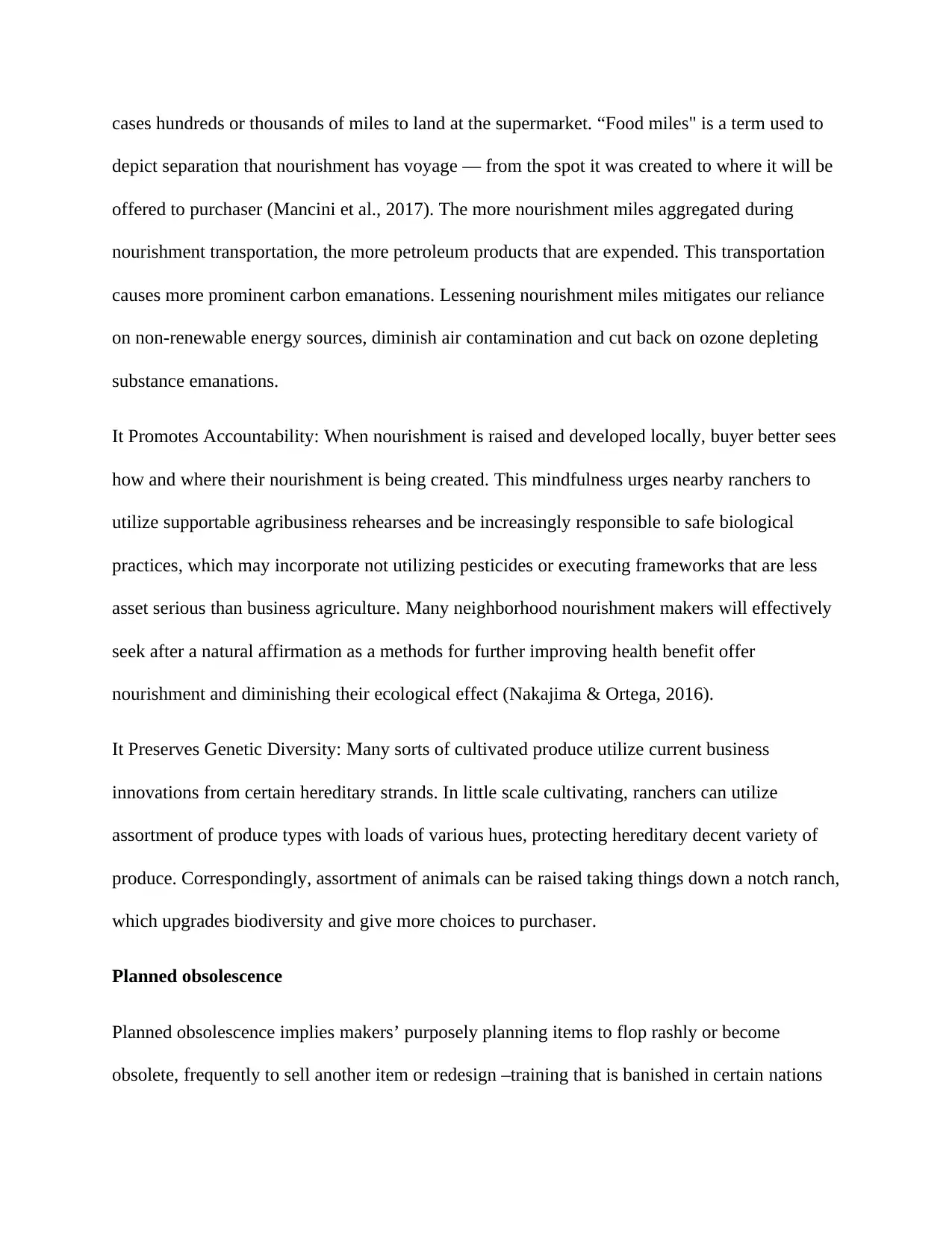
cases hundreds or thousands of miles to land at the supermarket. “Food miles" is a term used to
depict separation that nourishment has voyage — from the spot it was created to where it will be
offered to purchaser (Mancini et al., 2017). The more nourishment miles aggregated during
nourishment transportation, the more petroleum products that are expended. This transportation
causes more prominent carbon emanations. Lessening nourishment miles mitigates our reliance
on non-renewable energy sources, diminish air contamination and cut back on ozone depleting
substance emanations.
It Promotes Accountability: When nourishment is raised and developed locally, buyer better sees
how and where their nourishment is being created. This mindfulness urges nearby ranchers to
utilize supportable agribusiness rehearses and be increasingly responsible to safe biological
practices, which may incorporate not utilizing pesticides or executing frameworks that are less
asset serious than business agriculture. Many neighborhood nourishment makers will effectively
seek after a natural affirmation as a methods for further improving health benefit offer
nourishment and diminishing their ecological effect (Nakajima & Ortega, 2016).
It Preserves Genetic Diversity: Many sorts of cultivated produce utilize current business
innovations from certain hereditary strands. In little scale cultivating, ranchers can utilize
assortment of produce types with loads of various hues, protecting hereditary decent variety of
produce. Correspondingly, assortment of animals can be raised taking things down a notch ranch,
which upgrades biodiversity and give more choices to purchaser.
Planned obsolescence
Planned obsolescence implies makers’ purposely planning items to flop rashly or become
obsolete, frequently to sell another item or redesign –training that is banished in certain nations
depict separation that nourishment has voyage — from the spot it was created to where it will be
offered to purchaser (Mancini et al., 2017). The more nourishment miles aggregated during
nourishment transportation, the more petroleum products that are expended. This transportation
causes more prominent carbon emanations. Lessening nourishment miles mitigates our reliance
on non-renewable energy sources, diminish air contamination and cut back on ozone depleting
substance emanations.
It Promotes Accountability: When nourishment is raised and developed locally, buyer better sees
how and where their nourishment is being created. This mindfulness urges nearby ranchers to
utilize supportable agribusiness rehearses and be increasingly responsible to safe biological
practices, which may incorporate not utilizing pesticides or executing frameworks that are less
asset serious than business agriculture. Many neighborhood nourishment makers will effectively
seek after a natural affirmation as a methods for further improving health benefit offer
nourishment and diminishing their ecological effect (Nakajima & Ortega, 2016).
It Preserves Genetic Diversity: Many sorts of cultivated produce utilize current business
innovations from certain hereditary strands. In little scale cultivating, ranchers can utilize
assortment of produce types with loads of various hues, protecting hereditary decent variety of
produce. Correspondingly, assortment of animals can be raised taking things down a notch ranch,
which upgrades biodiversity and give more choices to purchaser.
Planned obsolescence
Planned obsolescence implies makers’ purposely planning items to flop rashly or become
obsolete, frequently to sell another item or redesign –training that is banished in certain nations
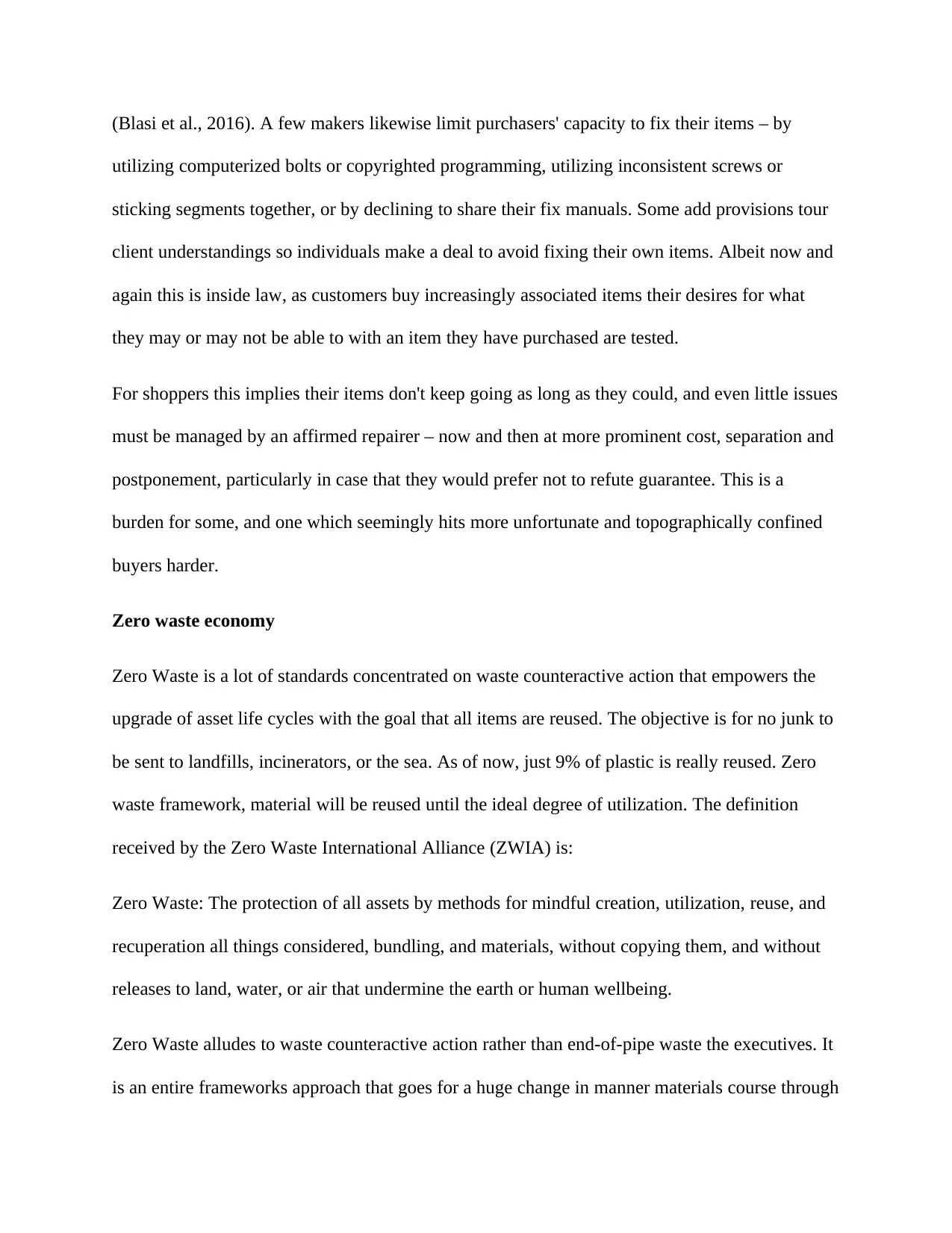
(Blasi et al., 2016). A few makers likewise limit purchasers' capacity to fix their items – by
utilizing computerized bolts or copyrighted programming, utilizing inconsistent screws or
sticking segments together, or by declining to share their fix manuals. Some add provisions tour
client understandings so individuals make a deal to avoid fixing their own items. Albeit now and
again this is inside law, as customers buy increasingly associated items their desires for what
they may or may not be able to with an item they have purchased are tested.
For shoppers this implies their items don't keep going as long as they could, and even little issues
must be managed by an affirmed repairer – now and then at more prominent cost, separation and
postponement, particularly in case that they would prefer not to refute guarantee. This is a
burden for some, and one which seemingly hits more unfortunate and topographically confined
buyers harder.
Zero waste economy
Zero Waste is a lot of standards concentrated on waste counteractive action that empowers the
upgrade of asset life cycles with the goal that all items are reused. The objective is for no junk to
be sent to landfills, incinerators, or the sea. As of now, just 9% of plastic is really reused. Zero
waste framework, material will be reused until the ideal degree of utilization. The definition
received by the Zero Waste International Alliance (ZWIA) is:
Zero Waste: The protection of all assets by methods for mindful creation, utilization, reuse, and
recuperation all things considered, bundling, and materials, without copying them, and without
releases to land, water, or air that undermine the earth or human wellbeing.
Zero Waste alludes to waste counteractive action rather than end-of-pipe waste the executives. It
is an entire frameworks approach that goes for a huge change in manner materials course through
utilizing computerized bolts or copyrighted programming, utilizing inconsistent screws or
sticking segments together, or by declining to share their fix manuals. Some add provisions tour
client understandings so individuals make a deal to avoid fixing their own items. Albeit now and
again this is inside law, as customers buy increasingly associated items their desires for what
they may or may not be able to with an item they have purchased are tested.
For shoppers this implies their items don't keep going as long as they could, and even little issues
must be managed by an affirmed repairer – now and then at more prominent cost, separation and
postponement, particularly in case that they would prefer not to refute guarantee. This is a
burden for some, and one which seemingly hits more unfortunate and topographically confined
buyers harder.
Zero waste economy
Zero Waste is a lot of standards concentrated on waste counteractive action that empowers the
upgrade of asset life cycles with the goal that all items are reused. The objective is for no junk to
be sent to landfills, incinerators, or the sea. As of now, just 9% of plastic is really reused. Zero
waste framework, material will be reused until the ideal degree of utilization. The definition
received by the Zero Waste International Alliance (ZWIA) is:
Zero Waste: The protection of all assets by methods for mindful creation, utilization, reuse, and
recuperation all things considered, bundling, and materials, without copying them, and without
releases to land, water, or air that undermine the earth or human wellbeing.
Zero Waste alludes to waste counteractive action rather than end-of-pipe waste the executives. It
is an entire frameworks approach that goes for a huge change in manner materials course through
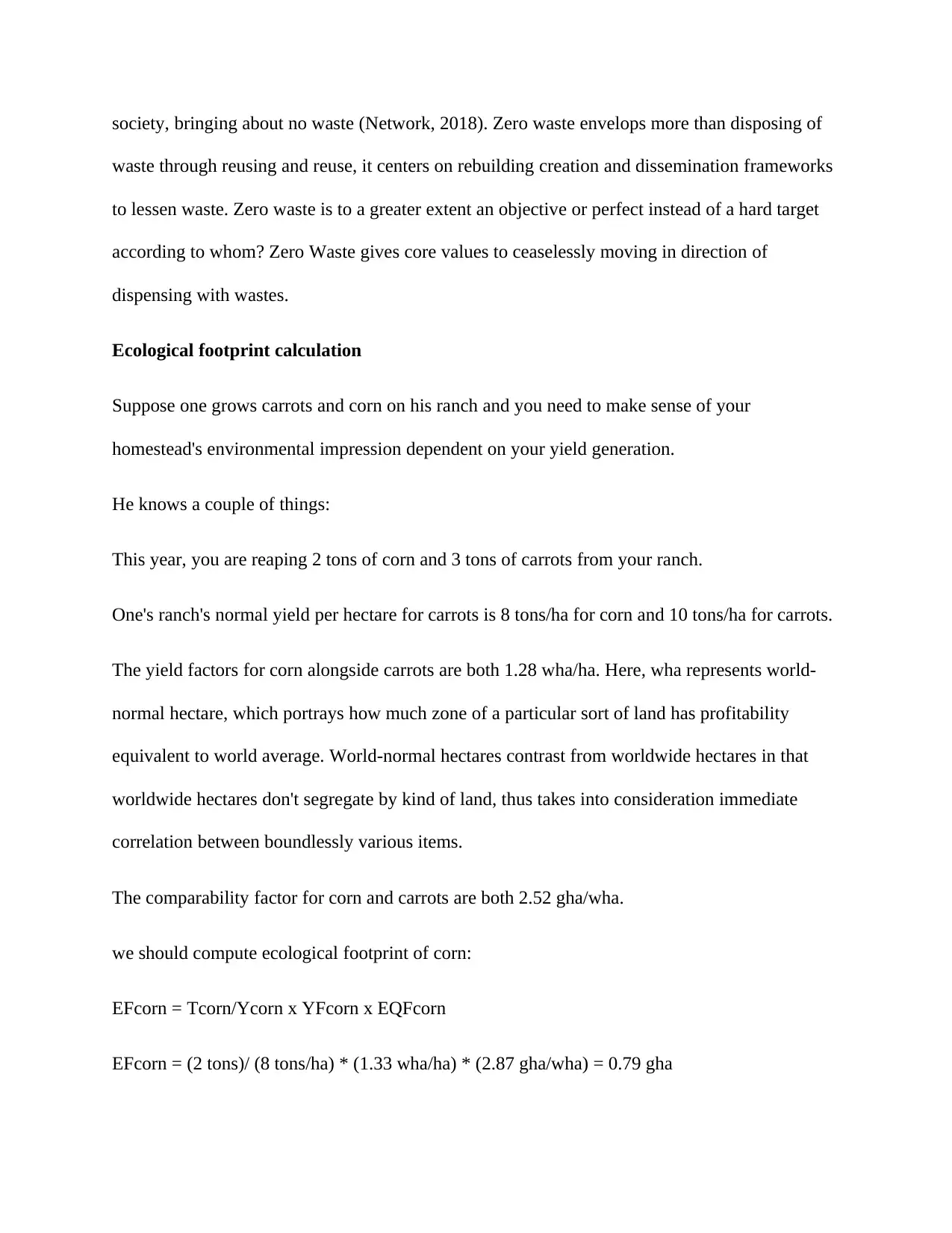
society, bringing about no waste (Network, 2018). Zero waste envelops more than disposing of
waste through reusing and reuse, it centers on rebuilding creation and dissemination frameworks
to lessen waste. Zero waste is to a greater extent an objective or perfect instead of a hard target
according to whom? Zero Waste gives core values to ceaselessly moving in direction of
dispensing with wastes.
Ecological footprint calculation
Suppose one grows carrots and corn on his ranch and you need to make sense of your
homestead's environmental impression dependent on your yield generation.
He knows a couple of things:
This year, you are reaping 2 tons of corn and 3 tons of carrots from your ranch.
One's ranch's normal yield per hectare for carrots is 8 tons/ha for corn and 10 tons/ha for carrots.
The yield factors for corn alongside carrots are both 1.28 wha/ha. Here, wha represents world-
normal hectare, which portrays how much zone of a particular sort of land has profitability
equivalent to world average. World-normal hectares contrast from worldwide hectares in that
worldwide hectares don't segregate by kind of land, thus takes into consideration immediate
correlation between boundlessly various items.
The comparability factor for corn and carrots are both 2.52 gha/wha.
we should compute ecological footprint of corn:
EFcorn = Tcorn/Ycorn x YFcorn x EQFcorn
EFcorn = (2 tons)/ (8 tons/ha) * (1.33 wha/ha) * (2.87 gha/wha) = 0.79 gha
waste through reusing and reuse, it centers on rebuilding creation and dissemination frameworks
to lessen waste. Zero waste is to a greater extent an objective or perfect instead of a hard target
according to whom? Zero Waste gives core values to ceaselessly moving in direction of
dispensing with wastes.
Ecological footprint calculation
Suppose one grows carrots and corn on his ranch and you need to make sense of your
homestead's environmental impression dependent on your yield generation.
He knows a couple of things:
This year, you are reaping 2 tons of corn and 3 tons of carrots from your ranch.
One's ranch's normal yield per hectare for carrots is 8 tons/ha for corn and 10 tons/ha for carrots.
The yield factors for corn alongside carrots are both 1.28 wha/ha. Here, wha represents world-
normal hectare, which portrays how much zone of a particular sort of land has profitability
equivalent to world average. World-normal hectares contrast from worldwide hectares in that
worldwide hectares don't segregate by kind of land, thus takes into consideration immediate
correlation between boundlessly various items.
The comparability factor for corn and carrots are both 2.52 gha/wha.
we should compute ecological footprint of corn:
EFcorn = Tcorn/Ycorn x YFcorn x EQFcorn
EFcorn = (2 tons)/ (8 tons/ha) * (1.33 wha/ha) * (2.87 gha/wha) = 0.79 gha
Paraphrase This Document
Need a fresh take? Get an instant paraphrase of this document with our AI Paraphraser

Presently, how about we do likewise for your carrots:
EFcarrots = (4 tons)/ (10 tons/ha) * (1.45 wha/ha) * (2.87 gha/wha) = 1.06 gha
In this manner, the natural impression of developing your harvests is:
0.79 gha + 1.06 gha = 1.85 gha
This implies so as to develop one’s yields, one would require 1.85 hectares of organically
beneficial land with efficiency proportional to world normal. One may include more terms to
contemplate different components, similar to how a lot of power one may need to run one’s
ranch.
References
EFcarrots = (4 tons)/ (10 tons/ha) * (1.45 wha/ha) * (2.87 gha/wha) = 1.06 gha
In this manner, the natural impression of developing your harvests is:
0.79 gha + 1.06 gha = 1.85 gha
This implies so as to develop one’s yields, one would require 1.85 hectares of organically
beneficial land with efficiency proportional to world normal. One may include more terms to
contemplate different components, similar to how a lot of power one may need to run one’s
ranch.
References

Blasi, E., Passeri, N., Franco, S., & Galli, A. (2016). An ecological footprint approach to
environmental–economic evaluation of farm results. Agricultural systems, 145, 76-82
Galli, A., Giampietro, M., Goldfinger, S., Lazarus, E., Lin, D., Saltelli, A., ... & Müller, F.
(2016). Questioning the ecological footprint. Ecological Indicators, 69, 224-232
He, J., Wan, Y., Feng, L., Ai, J., & Wang, Y. (2016). An integrated data envelopment analysis
and emergy-based ecological footprint methodology in evaluating sustainable development, a
case study of Jiangsu Province, China. Ecological indicators, 70, 23-34
Mancini, M. S., Galli, A., Coscieme, L., Niccolucci, V., Lin, D., Pulselli, F. M., ... &
Marchettini, N. (2018). Exploring ecosystem services assessment through Ecological Footprint
accounting. Ecosystem services, 30, 228-235
Mancini, M. S., Galli, A., Niccolucci, V., Lin, D., Bastianoni, S., Wackernagel, M., &
Marchettini, N. (2016). Ecological footprint: refining the carbon footprint
calculation. Ecological indicators, 61, 390-403
Mancini, M. S., Galli, A., Niccolucci, V., Lin, D., Hanscom, L., Wackernagel, M., ... &
Marchettini, N. (2017). Stocks and flows of natural capital: Implications for Ecological
Footprint. Ecological Indicators, 77, 123-128
Nakajima, E. S., & Ortega, E. (2016). Carrying capacity using emergy and a new calculation of
the ecological footprint. Ecological Indicators, 60, 1200-1207
Network, G. F. (2018). Ecological footprint. The Share Guide: The Holistic Health Magazine
and Resource Directory.< http://www. shareguide. com/Ecological. html>(25 March 2008)
environmental–economic evaluation of farm results. Agricultural systems, 145, 76-82
Galli, A., Giampietro, M., Goldfinger, S., Lazarus, E., Lin, D., Saltelli, A., ... & Müller, F.
(2016). Questioning the ecological footprint. Ecological Indicators, 69, 224-232
He, J., Wan, Y., Feng, L., Ai, J., & Wang, Y. (2016). An integrated data envelopment analysis
and emergy-based ecological footprint methodology in evaluating sustainable development, a
case study of Jiangsu Province, China. Ecological indicators, 70, 23-34
Mancini, M. S., Galli, A., Coscieme, L., Niccolucci, V., Lin, D., Pulselli, F. M., ... &
Marchettini, N. (2018). Exploring ecosystem services assessment through Ecological Footprint
accounting. Ecosystem services, 30, 228-235
Mancini, M. S., Galli, A., Niccolucci, V., Lin, D., Bastianoni, S., Wackernagel, M., &
Marchettini, N. (2016). Ecological footprint: refining the carbon footprint
calculation. Ecological indicators, 61, 390-403
Mancini, M. S., Galli, A., Niccolucci, V., Lin, D., Hanscom, L., Wackernagel, M., ... &
Marchettini, N. (2017). Stocks and flows of natural capital: Implications for Ecological
Footprint. Ecological Indicators, 77, 123-128
Nakajima, E. S., & Ortega, E. (2016). Carrying capacity using emergy and a new calculation of
the ecological footprint. Ecological Indicators, 60, 1200-1207
Network, G. F. (2018). Ecological footprint. The Share Guide: The Holistic Health Magazine
and Resource Directory.< http://www. shareguide. com/Ecological. html>(25 March 2008)
1 out of 9
Your All-in-One AI-Powered Toolkit for Academic Success.
+13062052269
info@desklib.com
Available 24*7 on WhatsApp / Email
![[object Object]](/_next/static/media/star-bottom.7253800d.svg)
Unlock your academic potential
© 2024 | Zucol Services PVT LTD | All rights reserved.